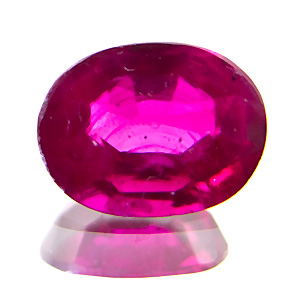Gemstone Glossary
Gemmology
American English: gemology; the science of gemstones, part of mineralogy with the handicap of having to identify gemstones non-destructively
Geneva ruby
Because of their high value, Rubies are amongst the gems that are synthesized and imitated most often. The earliest synthetic gems, the so-called "Geneva Rubies", were produced as early as 1885 and sold as genuine Rubies by a Geneva dealer.
In 1886 Paris jewellers gave the Sorbonne University some Geneva Rubies for examination. A Professor Friedel found them to possess the same density, hardness and optical properties as natural rubies. However, under magnification Friedel found numerous gas bubbles typical for glass and rightly concluded that the rubies were produced by some kind of high-temperature fusion process.

After it was decreed that these rubies were not to be sold as natural, claims were made that the stones were indeed produced by a flame-fusion process but that the starting material was fragments that were left over during the cutting of natural rubies.
For the next twenty years Geneva Rubies were being sold as "Reconstructed Rubies" at prices of $25 to $40 p.ct. until they were finally pushed off-market by the far superior Verneuil synthetics in 1904.
Girdle
Junction of upper and lower part of a gem, sometimes divided into many small facets. Should always be polished as unpolished girdles distract from brilliance. Thick girdles mean excess weight and are difficult to set, razor-sharp girdles are likely to chip during setting
Glass
There are glass imitations of almost any kind of gemstones. With some practice and a good loupe identification poses no big problem, though.
The most important diagnostic features are:
- conchoidal fracture (beware: also seen in quartzes and other gems)
- somewhat blunt facet edges (with signs of wear in older "stones")
- round gas bubbles
- often with flowmarks
With larger specimens a simple test of thermal conductivity can be performed to distinguish glass from crystalline material:
Let the stone in question rest next to a definitely crystalline material for a few minutes so that both can assume the same temperature.
Attention: the test only works with crystalline material. It does not work with e.g. Opal, Coral, Amber, Pearls, Ivory and the like. The stone to be tested as well as the reference stone must be of a minimum size, say about 10mm. Small stones assume body temperature far too quickly during testing.
Take the stones up, one after the other, quickly and touch a heat-sensitive spot like lips, eyelid or earlobe. It is imperative to do this as quickly as possible to prevent the stones from assuming body temperature.
Glass feels distinctly warmer than crystal. The difference is quite pronounced.
If you ask yourself whether there is a difference then either there is none (as stated above, if there is a difference, it´s strong), which means that the speciemn is not glass, or the specimens did not have enough time to assume the same temperature.
The test also works with stones in settings, as long as they are large enough to ensure that you do not touch the metal, which always feels cold.
Glyptic
The art or process of carving or engraving gemstones
 Deutsch
Deutsch